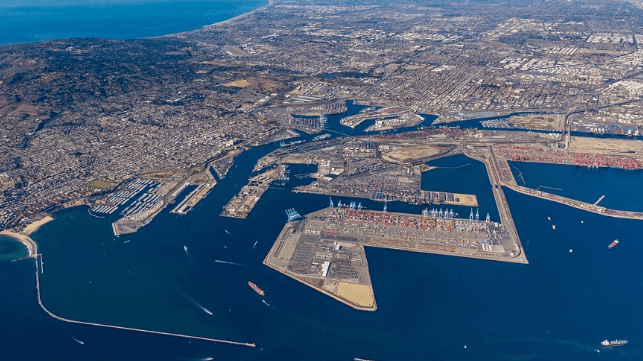Port Efficiency Index: San Pedro Bay Ranks Last, Mideast Ports Shine

The pressures placed on the global supply chain due to the pandemic shined a light on the challenges for ports and the emerging issues to increase operating efficiency to address the growing volumes. The second edition of the global Container Port Performance Index (CPPI) developed by the World Bank and S&P Global Market Intelligence seeks to identify the gaps and opportunities for improvement that will ultimately benefit all stakeholders in the shipping industry and beyond. The results released today highlight the emergence of new high-efficiency ports, especially in the Middle East, while older and larger container ports ranked among the least productive.
Highlighting the impact of the supply chain crisis on the efficiency and competitiveness of ports, two of the U.S busiest ports, Los Angeles and Long Beach, ranked as the most inefficient globally coming in the last place in the ranking of 370 global ports. Other major ports in North America, including Savannah, Seattle, and Vancouver, as well as Europe’s largest container ports at Rotterdam, Felixstowe, and Hamburg, were all among the lower rankings. By contrast, ports in the Middle East took four of the five top spots and three of the large Chinese gateways were also among the top 10 rankings.
In their report, the authors note that “how a maritime port performs is a crucial element in the cost of international trade for a country. Unfortunately, ports and terminals, particularly for containers, can often be sources of shipment delays, supply chain disruptions, additional costs, and reduced competitiveness,” they note saying the goal of the CPPI is to intended to serve as a reference point for key stakeholders in the global economy identifying gaps and opportunities for improvement.
The ranking is based on the time vessels needed to spend in port to complete workloads over the course of 2021. The authors note that it was a year that saw unprecedented port congestion and disruption to global supply chains. They said that the key port performance metrics show large discrepancies in global port efficiency.
Poorly performing ports are characterized by limitations in spatial and operating efficiency, limitations in maritime and landside access, inadequate oversight, and poor coordination between the public agencies involved, resulting in a lack of predictability and reliability write the authors of the report.
Highlighting the differences in efficiency, they reported that the top performers such as the King Abdullah Port in Saudi Arabia achieved an average of 97 container moves per hour of vessel port time. This compared with just 26 container moves per hour at the main ports on North America's West Coast.
“Inefficient ports represent a significant risk for many developing countries in that they can hinder economic growth, harm employment, and increase costs for importers and exporters,” said Martin Humphreys, Lead Transport Economist at the World Bank and one of the researchers behind the index. He added that in the Middle East, heavy investments in container port infrastructure and technology are proving to be effective in enhancing efficiency and competitiveness. Increasing the use of digital technology and green fuel alternatives are also two ways countries can modernize their ports and make maritime supply chains more resilient.
Saudi Arabia’s King Abdullah Port tops the ranking in 2021, with regional competitors Port Salalah in Oman, Hamad Port in Qatar, and Khalifa Port in Abu Dhabi rounding out the top five. Three of the large Chinese gateways, Shanghai (Yangshan), Ningbo, and the southern port of Guangzhou, also feature in the top 10, despite the challenges they faced in 2021 primarily due to COVID-related restrictions.
"Increasing the use of digital technology and green fuel alternatives are two ways countries can modernize their ports and make maritime supply chains more resilient," Martin Humphreys.
There are 37 new entrants to the CPPI 2021, and several significant movers in terms of their ranking since the 2020 report. One hundred and forty-nine ports improved their rankings in CPPI 2021, compared to CPPI 2020, with some of the largest improvers increasing their ranking by over 200 positions. By contrast, the ranking of 182 ports fell in the CPPI 2021, over the inaugural edition, with some of the largest movers falling nearly 300 positions, reflecting the challenges faced by ports in 2021. For example, last year's most efficient port – Yokohama in Japan – dropped to 10th place overall and Qingdao, China which was third in 2021 plunged to 42 in this year’s rankings.
Ranked at 23, the port of Virginia is the top ranked port in North America, followed by Miami at 29 and Halifax, Canada at 46. The Moroccan port of Tanger-Med, ranked at 6, is the highest in Europe and North Africa. Cartagena, Colombia at 12 ranks highest in Latin America and the Caribbean, while Port Matadi, Democratic Republic of Congo at 171 is the best performing port in Sub-Saharan Africa.
The twin ports of Los Angeles and Long Beach, where the backlog of containerships ballooned in 2021 to a peak of 109 at the beginning of 2022, were ranked last at 369 and 370. Savannah and Vancouver were also at the bottom coming in alongside ports including Durban and Cape Town, South Africa which have been consistently recognized as among the least efficient in the world.

that matters most
Get the latest maritime news delivered to your inbox daily.
"The pandemic highlighted in stark terms the pivotal role port performance plays in the timely supply of goods to countries and their populations. The effects of the pandemic on key global gateways and associated supply chains are very worrying and continue to cause severe supply delays and shortages of goods, leading to higher prices and negatively impacting the financial situation of many companies," concluded Turloch Mooney, Associate Director, Maritime and Trade at S&P Global Market Intelligence.
The complete report is available online.
